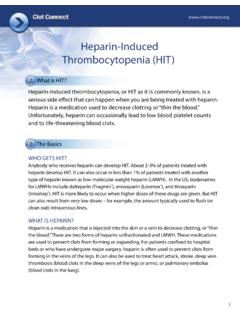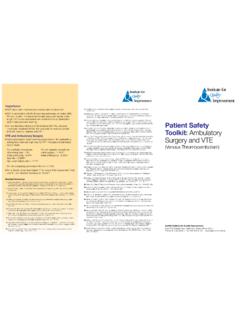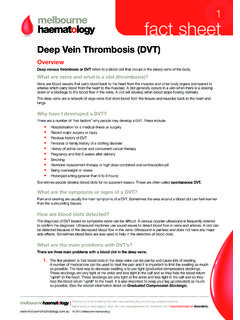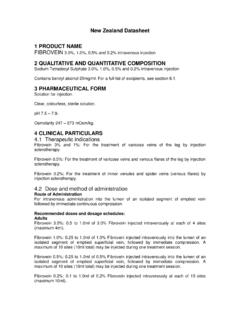Transcription of Compression stockings after deep vein thrombosis …
1 1 HEMOPHILIA AND thrombosis CENTER OF THE UNIVERSITY OF NORTH CAROLINA AT CHAPEL HILL Compression stockings after deep vein thrombosis (DVT) If you have had a blood clot in the leg ( deep vein thrombosis , DVT) and have leg pain and swelling, your leg may feel better with Compression stockings . Compression stockings are used to: A. Improve symptoms of pain and swelling following acute DVT B. Improve symptoms of pain and swelling from post-thrombotic syndrome (PTS) Post-thrombotic syndrome (PTS) occurs in approximately 40% of persons with DVT and varies from person-to-person in its severity. Symptoms of PTS include: Chronic swelling Chronic pain, pressure, heaviness, tightness or leg tiredness Skin hardening or itching Dark pigmentation, visible spider veins Ulcers (skin breakdown) Special graduated Compression stockings are designed to decrease or prevent swelling.
2 They keep fluid from pooling in the ankle, calf and thigh. In the past, Compression stockings were recommended for most patients with DVT because it was thought the stockings could prevent PTS. Recent research however has shown that elastic Compression stockings after a first episode of leg DVT do not prevent PTS. (Reference 1) Even though Compression stockings may not prevent PTS, they may make your leg feel better and reduce pain and swelling. Ask your health care provider if Compression stockings would be helpful for you. 2 How do Compression stockings work? Compression stockings are made of a special elastic fabric. They are very tight at the ankle and are less tight as the stocking moves up the leg. This graduated tightness helps the leg muscles squeeze fluid up the leg, which improves blood flow from the leg back to the heart and decreases leg swelling and pain.
3 What kind of Compression stockings do I need? Compression stockings come in different levels of tightness. The level of tightness is expressed in millimeters of mercury (mmHg). Your health care provider will indicate on the prescription which strength of stocking you need. The most common recommended tightness following DVT is 30 to 40 mmHg pressure. It is also referred to as grade 2 . Compression stockings should be individually fitted. The leg should be measured to insure correct fit. TED- stockings (short for thromboembolism-deterrent hose) are not sufficiently tight they have less pressure than what is useful to treat the swelling after a DVT. stockings up to 20mmHg pressure do not require a prescription. stockings above 20mmHg should be used only with the advice or prescription of a physician and proper sizing from a trained fitter.
4 Compression stockings come in different styles: knee-high, thigh-high or full-length. If the leg swelling is below the knee, then a below-knee stocking is appropriate, but if swelling also involves the thigh, then an above-knee stocking may be a better choice. Where do I buy Compression stockings ? Many pharmacies and medical supply companies carry Compression stockings . Ask the health care provider who writes your prescription for Compression stockings if there is a supplier in your area he/she recommends. Some insurance carriers cover Compression stockings while others do not. Consult your insurance benefit to see if Compression stockings are covered under your insurance plan. Compression stocking costs range between $40 to $90 per pair, depending upon the brand, style and Compression level.
5 3 How do I wear Compression stockings ? Compression stockings can be worn following a DVT once the initial more pronounced swelling of a DVT has improved, after about 1 week. Put your stocking on first thing in the morning, before you are up on your feet. Remove stockings at bedtime. There is no need to wear them at night. Most stockings are sold in pairs, but you need only to wear a stocking on the leg affected by the DVT. You should wear Compression stockings every day for as long as they continue to make your leg feel better. The length of time will vary by individual and may be weeks, months or years. For example, if swelling has disappeared a few weeks or months after the acute DVT with the use of the stockings , you may stop wearing the stocking.
6 If swelling recurs, then the stocking should be worn again. If there is no more swelling, then stockings are not needed any more. How do I put on the Compression stockings ? Compression stockings are designed to be tight. They can take a little effort to pull on. To make it easier: Put Compression stockings on first thing in the morning before you start moving around much, when your leg is less swollen. Makes sure your skin is dry. If you use lotion, be sure it is completely absorbed before putting on the stocking. Talcum powder can help make the stocking glide on more smoothly. Put the stocking first completely over the foot, then over the heel and finally up covering the calf or thigh. Getting the heel in position first will make the process easier.
7 Do not pull the stocking by the top. Gently pull the stocking up the leg, smoothing the extra material as you go along. For knee-length stockings , once on properly, the top of the stocking should be about one-inch below the bend of the knee. Medical supply stores carry devices which can help guide the stocking smoothly over the leg. Ask about stocking aides . Do not fold or roll down the stop of the stocking. If you feel that is needed, then you probably need a shorter stocking. If your stocking keeps falling or sliding down, you may need a different size. 4 How do I care for Compression stockings ? Follow the instructions on the label for washing the stockings . In general: Wash the stockings after each use. Washing removes oils and dirt and helps fabric keep elasticity.
8 Hand or machine wash - check the label for specific recommendation. If machine washing, use of a mesh laundry bag can protect the stockings during the wash cycle. Wash in mild soap. Do not use detergent as this can affect the elasticity of the fabric. Rinse the fabric completely. Pat dry the stocking with a towel. Do not wring and twist. Air-dry the stocking. Some stockings can be dried on the delicate cycle of a dryer - check the label. Replace Compression stockings as needed. Over time, the fabric will lose its elasticity. stockings last about 4 to 6 months. FOR MORE INFORMATION To learn more about deep vein thrombosis and post-thrombotic syndrome, visit REFERENCES 1. Kahn SR et al. Compression stockings to prevent post-thrombotic syndrome: a randomised placebo-controlled trial.
9 Lancet, published online Dec 6, 2013. Last updated: January 2014








